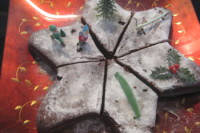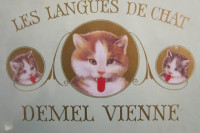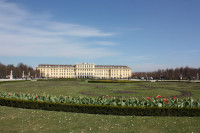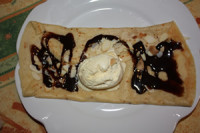Featured articles
My favorite cakes and desserts: taste them once, and you will want more!
This month I would like to share with you a few interesting facts about my favorite cakes and desserts. I have chosen specialities from France, Germany, Switzerland and Austria.
Kugelhopf (France)
Have you ever heard of a Kugelhopf?
Maybe the name does not ring a bell, but if you had the chance to visit the Alsatian region, you could not miss the displays of Kugelhopf in the bakeries windows.
I finally bought my first one this month. I don’t know how I could have waited so long! It was so delicious. Now, I just need to go back!
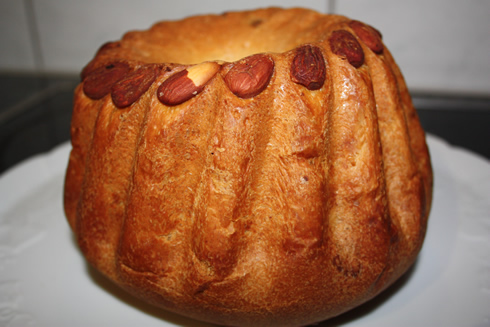
Alsatian Kugelhopf with almonds
What does it taste like? It is similar to a brioche (a yeast bread with butter), but it is much more than that. It has raisins, is flavored with kirsch and the outside is decorated with almonds and powdered sugar.
The French, Austrians and Germans all eat it and love it. And all say they invented it. As Alsace used to be a part of Germany, it was once German. Every year in June in the streets of the town of Ribeauvillé, there is a Kugelhopf festival. Why in Ribeauvillé? Some believe the Three Wise Kings would have stopped there on the way to Cologne from Bethlehem and they were served a cake named Kugelhopf.
The Austrians said they invented it after defeating the Turks in the late 17th century. In remembrance they baked a cake in the shape of a turban. The cake recipe was supposedly introduced by the Hapsburgs to the French court. Marie Antoinette is said to have brought the recipe with her when she married the French king. It was also the emperor Franz Joseph favorite’s.
So that’s why the Kugelhopf has different spellings like Gugelhupf in Austria, Switzerland and Germany, Kougelhopf, Kougloff in France and Kuglof in Hungary….
The cake is cooked in a terra-cotta or metal mold. You may have seen some beautiful decorated molds in Alsatian stores. It has a hole in the middle, making it look like a turban.
It is delicious for tea time or in the morning for breakfast.
Let me tell you, despite the hefty price bakers charge for it, I will not wait too much longer to buy one Kugelhopf. One more reason to drive back to Alsace.
Vermicelle
I was with a friend the other day for tea time in a Swiss restaurant and she said she was going to order a Vermicelle.
A Vermicelle? I replied. I never had one. Is that good?
She waved at the waitress and ordered two vermicelles.
Heaven! The look was fabulous, some chestnuts cream on a meringue with whipped cream and served with fresh fruits, a dried biscuit and chocolate in the outside.
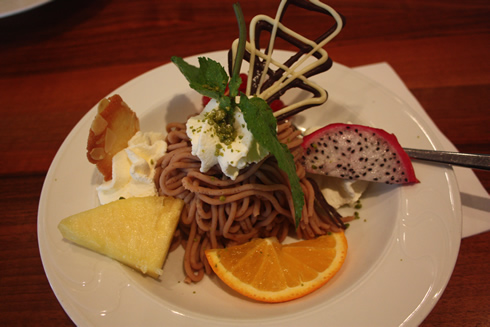
A plate of Vermicelle
It tasted as good as it looked. Now, my friend said “this one was a gourmet Vermicelle!” Normally it is not as fancy as this one, just with a chestnut cream, meringue and whipped cream”. It can also be served on an empty buttered crust.
The dish is called Vermicelle because it looks like worms. It comes from the Italian word vermicelli, meaning thin long pasta like spaghetti.
The first book in Switzerland talking about Vermicelle came out in 1894, “the Universal dictionary of practical cooking” by Joseph Favre.
Apparently it is as popular in the country as Fondue and Raclette since at least 60 years. You can find it in dessert shops and in supermarkets.
Canelé
This speciality comes from Bordeaux in the southwest of France.
This little cake taste like a French crèpe in the inside but it is much harder to make than crèpes! The outside is brown and caramelized. I have never made it myself, but from what I have heard even pastry chefs have trouble making them. The inside has to remain soft.
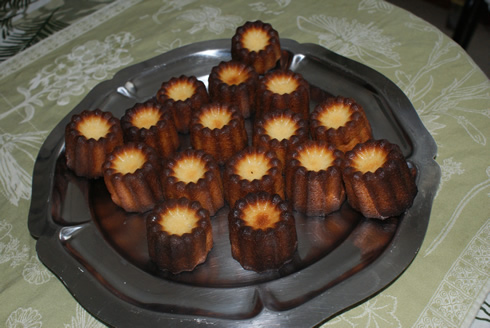
French specialty from Bordeaux – the canelés
My aunt and mother love baking them. You can buy molds of 8 or 16. It is better if eaten the same day of or soon after.
I think canelés are quite addictive, once you eat one, you want to eat the entire batch! I am not the only one who likes them. In Gironde, 4.5 millions were eaten in 1992 a decade of the name brand was registered!
It is difficult to know for sure when it was invented and by whom. Probably it came from the word canaule, a speciality from Limoges and later to Bordeaux. The people making them were the canauliers, artisans or pastry chefs. There was an edict in 1767 allowing only 8 shops in one city in the region.
Canelé used to be spelled cannelé until an n was dropped when the brand name was registered in the 1980’s. In the 1990’s there were about 1400 manufacturers of canelés in Gironde and Aquitaine.
Stollen or Christstollen
I am sure if you have been to a European Christmas market, especially in Germany, you have eaten or seen Christstollen. It is a cake full of dried fruits, almonds, spices and butter. It is topped with powdered sugar.
The first time I had some homemade stollen was for Easter in Austria. A friend of ours, in Vienna baked one for breakfast. It was delicious and since that day, I meant to bake one myself.
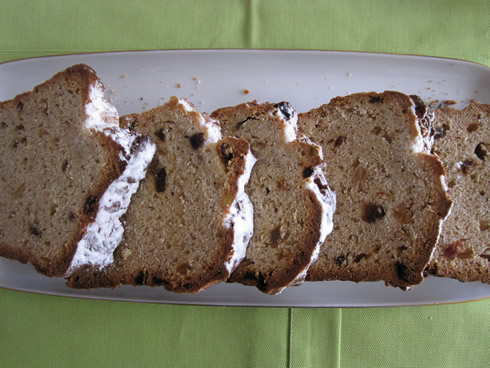
Freshly cut pieces of Christstollen
This cake is a speciality from Dresden in Eastern Germany. It was first baked in the medieval ages in 1427. At that time it was forbidden to use butter until 1491 when Pope Innocent VIII allowed it only for the town of Dresden.
It is found in Christmas markets, bakeries and supermarkets from September until January.
Why is it called Christstollen? It is a Christmas cake and it is supposed to remember Baby Jesus wrapped tightly in clothing.
This year Dresden will celebrate its 16th Christstollen festival. A giant stollen will be baked and displayed through the streets. For this occasion 2,6 millions dried raisins, 82 liters of rum and 1 ton of flour among other things are needed. The largest stollen of 4.2 tones was baked a decade ago.
In Dresden, over 2 millions Christmas cakes (about 100,000 kilos) are made each year, that’s a lot. There are 150 bakers in Dresden who prepare the stollens.
The famous Konditorei in Dresden Kreutzhamm makes stollen since 1825. Elizabeth Kreutzhamm-Aumüller who inherited the company from her great great grand father, revealed for the newspaper Süddeutsche Zeitung in 2009 that are put in her stollens only raisins from Australia and South Africa. She said the first stollens made are for America to get there just before Thanksgiving. They don’t use conservatives. She also mentioned that a large Christmas cake tastes better than a smaller one, making it moister.
The Bakery Kreutzhamm was invited to bake a stollen for President Bush and Chancellor Kohl in 2006 in Washington. It was for the German National Holiday in October.
If you buy some Christstollen for the holidays, the best is to store it in the cellar, on your balcony or somewhere between 3 to 10 degrees Celsius. Also don’t buy it too early, maximum 2 to 4 weeks before you eat it!
Sachertorte
I love just everything about Sachertorte, the name, the look and most of all the taste!
This Austrian dessert was invented in the 19th century in Vienna by Franz Sacher for Prince Metternich.
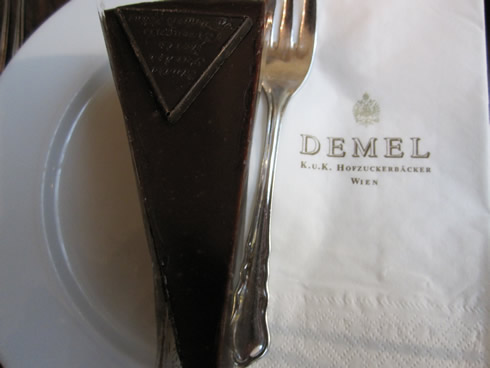
Piece of Sachertorte at Demel Konditorei in Vienna (Austria)
A young baker at the time, Sacher pleased the guests of the Prince, who had told him before the party: “Let there be no shame on me tonight!” However the fame of the Sachertorte came with his son, Edward Sacher, who improved it and what is known as today’s Sachertorte.
If you never had it before, it is a cake with layers of dark chocolate, apricot jam and chocolate icing. Normally it is served with whipped cream.
You may have tried it Vienna either at the Hotel Sacher or at Demel bakery and tea room. The two places fought for years for the inscription “Original Sacher Torte”. It is hotel Sacher who won in 1963.
Edward Sacher worked at Demel in Vienna where the final cake we know today was made. He later opened the Hotel Sacher in the late 1870’s.
Nowadays you will see the Original Sachertorte at Hotel Sacher, in Salzburg and at the airport in Vienna. Demel’s Sachertorte is sold at Demel. According to Hotel Sacher, the difference is in the chocolate icing.
Try them both and see which one you prefer! Guten Appetit!

